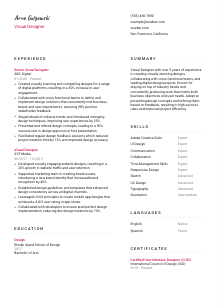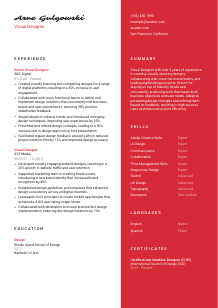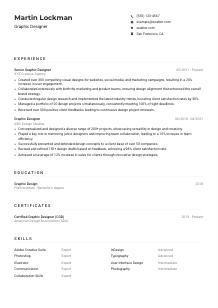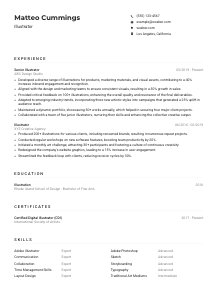Visual Designer Resume Example
Painting palettes, but your resume seems grayscale? Dive into this Visual Designer resume example, crafted using Wozber free resume builder. See how you can illustrate your design flair and layout literacy to align with job specifics, adding vibrant hues to your career canvas!

How to write a Visual Designer Resume?
Welcome, aspiring Visual Designer! In the creative and ever-evolving field of design, your resume isn't just a summary of your career; it's a canvas to showcase your talent, skillset, and passion. With the right approach, you can transform your resume into a masterpiece that captures the eye of hiring managers.
Leveraging Wozber's free resume builder, this guide is your palette for painting a resume that not only meets the specifics of your dream job but truly stands out. Let's embark on this creative journey to mold your resume into a key that unlocks new career opportunities!
Personal Details
The Personal Details section is like the header of a website – it's where first impressions are formed. Here's how to tailor it to encapsulate the essence of a successful Visual Designer.
1. Use Your Name as Your Brand
Your name is the first thing a hiring manager sees; make it memorable. Choose a clear, readable font that reflects your design style, setting a professional tone right off the bat.
2. Align Your Title with Your Aspirations
Directly below your name, assert your professional identity with the title 'Visual Designer.' This small yet significant step parallels the job description, signaling a direct match to hiring managers.
3. Essential Contact Info
- Phone Number: Ensure it's correct; a simple typo could mean a missed opportunity.
- Professional Email: Use a format like firstname.lastname@email.com. Keep it clean and professional.
4. Showcase Your Base
"Must be located in or willing to relocate to San Francisco, CA." If you're local or willing to move, highlight your San Francisco base right in your contact details. This instantly shows you meet one of the job's logistical needs.
5. Add a Professional Link
Including a link to your online portfolio beside your contact information invites hiring managers to see your work firsthand. Make sure it's updated and mirrors the creativity and professionalism of your resume.
Takeaway
Consider this section your introduction at a gallery opening. It's polished, professional, and perfectly suited for the Visual Designer role. A well-designed Personal Details section sets the stage for the artistry and detail that follows.





Experience
The Experience section is where your career story unfolds. It's your opportunity to prove you're the Visual Designer they've been searching for by illustrating how your past work aligns with their requirements.
- Created visually stunning and compelling designs for a range of digital platforms, resulting in a 30% increase in user engagement.
- Collaborated with cross‑functional teams to define and implement design solutions that consistently met business, brand, and user requirements, receiving 98% positive stakeholder feedback.
- Stayed ahead of industry trends and introduced emerging design techniques, improving user experiences by 25%.
- Presented and refined design concepts, leading to a 90% success rate in design approval on first presentation.
- Facilitated regular design feedback sessions which reduced project iteration time by 15% and improved design accuracy.
- Developed visually engaging website designs, resulting in a 20% growth in website traffic and user retention.
- Supported marketing team in creating brand assets, introducing a new brand identity that increased brand recognition by 40%.
- Established design guidelines and templates that enhanced design consistency across all digital channels.
- Leveraged UI/UX principles to create mobile app designs that achieved a 4.8/5 user rating in app stores.
- Collaborated with developers to ensure pixel‑perfect design implementation, reducing dev‑design iterations by 70%.
1. Highlighting the Right Experience
Start with a thorough read-through of the job description. Note down key responsibilities like 'Create visually stunning and compelling designs.' Tailor your past roles to reflect these duties, showing you're already well-practiced in what they need.
2. Present Your Journey
Chronologically list your roles, with the latest first. Showcase your career progression, from a Visual Designer to a Senior Visual Designer.
3. Achievements That Speak Volumes
Rather than a list of duties, focus on what you've accomplished. If you've led a project that resulted in a 30% increase in user engagement, that's a compelling narrative of your impact.
4. Numbers Make a Difference
Whenever possible, quantify your achievements. Percentages, user rating improvements, and project time reductions are persuasive evidence of your contribution and skill.
5. Relevancy is Key
Ensure every bullet point ties back to the job description. For example, if they emphasize collaboration, detail your experience working with cross-functional teams and the positive outcomes that ensued.
Takeaway
Your experience section is your personal gallery of professional accomplishments. Make it a captivating exhibition of projects and roles that demonstrate your expertise as a Visual Designer. Keep it relevant, quantified, and always linked to the job requirements.
Education
For many, the Education section is straightforward. But for a Visual Designer, it's an opportunity to show foundations that have shaped your design sensibilities and understanding.
1. Match the Degree Requirement
Highlight your Bachelor's degree in Design, Fine Arts, or a related field prominently. This immediately checks off a major requirement for the role.
2. Structuring the Details
List your degree, field of study, and the institution's name. Including your graduation year showcases how current your design education is, resonating with the ever-evolving nature of the field.
3. Degree Aligns with Role
Specificity is key. If the job specifies a preference for certain areas within design, make sure your degree reflects this. Tailor the presentation of your education to mirror the role's requirements as closely as possible.
4. Relevant Courses and Projects
While the broad stroke of a degree is crucial, highlighting particular courses or projects that directly relate to the responsibilities or skills outlined in the job description can further cement your qualifications.
5. Other Educational Highlights
If you have other accolades, like design competitions won or exhibitions participated in, that reflect your passion and skill in your field, don't hesitate to include them. For senior roles, focus on achievements that show leadership and initiative.
Takeaway
Your education is a testament to your foundation in the visual design space. It's more than dates and institution names; it's the bedrock of your understanding and the springboard for your creativity. Make sure it aligns closely with what the job is looking for.
Certificates
Certificates are your extra paintbrushes in your design toolkit. They show commitment to your craft and continuous learning. Especially in a field as dynamic as design, they can significantly bolster your resume.
1. Relevant Certifications Only
The job posting might not always specify certifications, but including relevant ones, such as the Certified User Interface Designer, can set you apart. Pick those that enhance your profile for the Visual Designer role.
2. Quality over Quantity
Focus on certifications that directly contribute to your expertise as a Visual Designer. Your goal is to show depth in your field, not just a broad array of unrelated credentials.
3. Date Matters
Include the acquisition date for your certifications to show that your skills are current. In the fast-paced world of design, freshness matters.
4. Keep Learning
The design world evolves rapidly. Show your commitment to staying ahead by seeking out new certifications and trainings. This dedication to your craft can make a strong impression.
Takeaway
Strategically chosen certifications are like the extra colors on your palette that make your work stand out. They signify a dedication to excellence and continuous improvement. Keep this section focused and updated with relevant certifications.
Skills
The Skills section of your resume is like the toolset in your design software – it's crucial to show you have the right tools for the job. Let's delve into how to present the most relevant skills for a Visual Designer position.
1. Decipher the Job Post
Go through the job description with a fine-tooth comb and list down the skills it mentions. For a Visual Designer, this includes proficiency in Adobe Creative Suite, a keen understanding of UI/UX principles, and strong collaboration skills.
2. Showcase Your Expertise
Once you've identified the key skills, match them against your own. Ensure to include both hard skills like Adobe Creative Suite expertise, as well as soft skills such as teamwork and time management. This paints a complete picture of your capabilities.
3. Clarity and Focus
Avoid crowding your skills section with every skill you possess. Concentrate on those most relevant to the job description. This targeted approach makes it easier for hiring managers to see your fit for the role at a glance.
Takeaway
Consider your skills section a highlight reel of your professional toolkit. By showcasing the precise tools you wield with expertise, you demonstrate not only a perfect match for the job but also the unique value you bring to the table. Keep sharpening your skills; they are the core of your creativity.
Languages
In a global field like visual design, the ability to communicate across cultures can be a valuable asset. Here's how to effectively present your linguistic skills in a way that adds color and global perspective to your resume.
1. Check for Requirements
Start by noting if the job specifies any language proficiency. The job description calls for "Proficient English language use." Therefore, ensure English tops your list with the appropriate proficiency level.
2. Prioritize Key Languages
List languages in order of relevance to the job. If the role requires interaction with global teams or markets, placing other languages you are fluent in directly after English can showcase your versatility.
3. Detail Your Proficiency
Be transparent about your level of proficiency in each language. Use terms like 'native,' 'fluent,' 'intermediate,' and 'basic' to give a clear understanding of your capability.
4. More Than Just Words
Even if additional languages beyond English aren't specified, including them can reflect a global mindset and adaptability - attractive traits in a creative field.
5. Assess the Role's Scope
If your role involves working with international teams or markets, the value of your multilingual ability magnifies. It can distinguish you as a candidate well-suited for global perspectives and collaboration.
Takeaway
Your ability to navigate different languages is akin to understanding different design languages – it is a powerful tool in your arsenal. Listing languages with precise proficiency levels paints you as a versatile and globally aware professional, adding a unique layer to your profile.
Summary
The Summary section is your opening statement, the compelling introduction before the deep dive. It's where you encapsulate your essence as a Visual Designer, drawing the hiring manager into your world. Let's sculpt a summary that encapsulates your brilliance.
1. Capture the Job Essence
Read the job description thoroughly and note down its spirit - the blend of creativity, technical skills, and teamwork required. Your summary should echo this blend, positioning you as the ideal candidate.
2. Introduce Your Professional Self
Lead with a strong opening line that highlights your years of experience and areas of expertise. For instance, starting with 'Visual Designer with over 5 years of experience' immediately establishes your credibility.
3. Highlight Key Achievements
Mention your major accomplishments and skills, especially those that resonate with the job description. This could include driving user engagement, cross-functional collaboration, or staying ahead of design trends.
4. Conciseness is Your Friend
Keep your summary tight and impactful. Three to five punchy lines are all you need to entice the hiring manager to delve deeper into your resume. Think of it as your personal brand slogan.
Takeaway
A compelling summary is your elevator pitch – it's what piques interest and entices further reading. Infuse it with your unique value proposition as a Visual Designer, ensuring it's a teaser of the expertise and creativity that follow. Let your summary set the stage for everything you bring to the table.
Launching Your Visual Designer Journey
As you wrap up tailoring your resume with these curated tips, remember that it's more than a document; it's a reflection of your creativity, skill, and passion. Use Wozber's free resume builder, featuring ATS-friendly resume templates and ATS optimization tools, to ensure your resume not only meets industry standards but exceeds them. Your journey as a Visual Designer is brimming with potential.
Let your resume be the key that opens the doors to new opportunities. Dive into your career canvas with confidence and let your creativity shine!

- Bachelor's degree in Design, Fine Arts, or a related field.
- Minimum of 4 years of professional design experience, preferably in a digital or agency setting.
- Expert proficiency with design software such as Adobe Creative Suite or Sketch.
- Proficient in using UI and UX design best practices.
- Strong communication, collaboration, and time management skills.
- Proficient English language use is a job necessity.
- Must be located in or willing to relocate to San Francisco, CA.
- Create visually stunning and compelling designs for digital platforms, including websites, mobile apps, and social media content.
- Collaborate with cross-functional teams to define and implement design solutions that meet business, brand, and user requirements.
- Stay up to date with industry trends and emerging design techniques to ensure the best user experiences.
- Present design concepts and solutions, and iterate based on feedback and stakeholder input.
- Work closely with developers to ensure the fidelity of the designs during the implementation phase.















